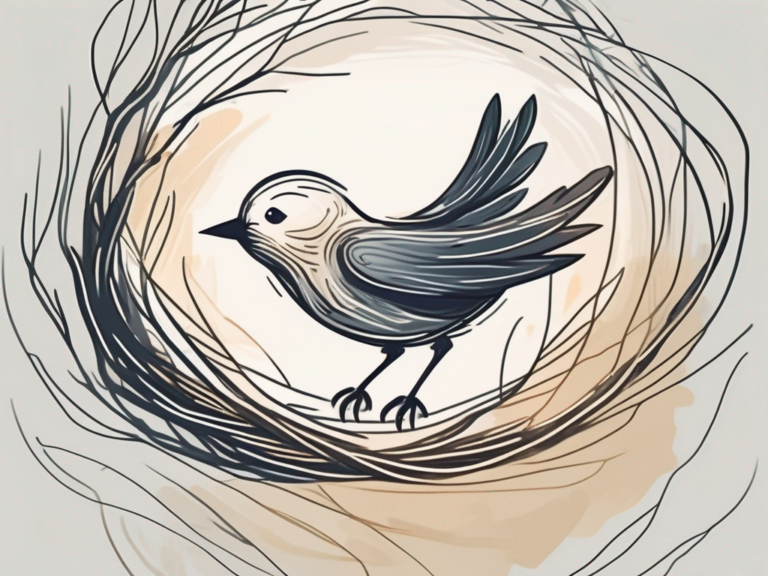The Role of the Abducens Nerve in Eye Movement
The abducens nerve, also known as the sixth cranial nerve, plays a crucial role in the complex process of eye movement. Understanding the anatomy and functions of this nerve is essential in comprehending how eye movements occur and the potential disorders that can arise from its dysfunction. In this article, we will delve into the various aspects of the abducens nerve, its role in eye movement, the impact of its damage on vision, and future research directions in this field.
Understanding the Abducens Nerve
The abducens nerve, also known as the sixth cranial nerve, plays a vital role in the intricate dance of eye movements. Specifically, it is responsible for the lateral movement of the eye, allowing for the abduction or outward rotation of the eye. This remarkable nerve emerges from the brainstem at the level of the pons, precisely from the abducens nucleus, and embarks on a fascinating journey through the cavernous sinus before innervating the lateral rectus muscle of the eye, the key player in eye abduction.
Anatomy of the Abducens Nerve
The abducens nerve, composed of approximately 1,200 to 1,500 individual nerve fibers, is a mixed motor nerve. While its primary function is to carry motor impulses to the lateral rectus muscle, it also contains a small number of sensory fibers. These sensory fibers contribute to proprioception, a remarkable sensory ability that provides information about the position and movement of the eye, allowing us to navigate the world with precision.
Tracing its path within the brainstem is like embarking on a captivating expedition. The abducens nerve originates from the abducens nucleus, nestled within the pons, and then embarks on a long and winding course through the lower part of the brainstem. As it ventures forth, it traverses the cavernous sinus, a complex network of veins and nerves, where it merges with other cranial nerves, including the oculomotor and trochlear nerves. This convergence forms the cranial nerve complex, a marvel of anatomical synergy.
Functions of the Abducens Nerve
The abducens nerve, with its intricate network of fibers, plays a crucial role in maintaining proper eye alignment and coordinating eye movements. Its primary function is to innervate the lateral rectus muscle, the unsung hero responsible for moving the eye laterally. This action allows for the divergence of the visual axes, enabling us to perceive the world in all its three-dimensional glory.
But the abducens nerve’s contribution to our visual experience doesn’t stop there. It also plays a part in gaze stability, working in harmony with other cranial nerves and brain structures to ensure that our eye movements are smooth, accurate, and coordinated. This symphony of coordination allows us to effortlessly follow a moving object or scan our surroundings, effortlessly taking in the beauty of the world around us.
However, when the abducens nerve encounters dysfunction, it can disrupt this delicate symphony. Eye movement disorders may arise, impacting our visual perception and causing challenges in daily life. Understanding the intricacies of the abducens nerve is not just a fascinating journey into the depths of human anatomy, but also a key to unraveling the mysteries of eye movements and their impact on our perception of the world.
The Abducens Nerve and Eye Movement
The mechanism of eye movement involves the coordinated action of several cranial nerves and extraocular muscles. The abducens nerve plays a vital role in this intricate process, specifically in the horizontal movement of the eyes.
Mechanism of Eye Movement
Eye movements can be broadly categorized into two main types: saccades and smooth pursuit. Saccades refer to the rapid, voluntary eye movements that allow us to shift our gaze between different targets in the visual field. Smooth pursuit refers to the slower, tracking movements that our eyes make to follow a moving object.
During saccadic movements, the abducens nerve works in coordination with the oculomotor nerve and other brain structures to initiate the appropriate contractions and relaxations of the extraocular muscles. This intricate interplay allows for precise and rapid shifts in gaze direction.
The Abducens Nerve’s Role in Lateral Eye Movement
The abducens nerve specifically controls the lateral rectus muscle, which acts to abduct the eye. When the abducens nerve is functioning correctly, it sends motor signals to the lateral rectus muscle, causing it to contract and pull the eye outward. This movement allows for the observation of objects in the periphery and plays a crucial role in our daily visual experiences.
It is worth noting that the abducens nerve also works in coordination with other extraocular muscles and cranial nerves to ensure the appropriate alignment of both eyes. This coordination is vital for binocular vision, depth perception, and the ability to maintain a clear and single image of the world around us.
Furthermore, the abducens nerve is not only responsible for lateral eye movement but also contributes to the overall stability of the eyes. It plays a significant role in maintaining eye position and preventing unwanted drifts or deviations. This constant monitoring and adjustment by the abducens nerve help us maintain a steady gaze and avoid visual disturbances.
Moreover, the abducens nerve is susceptible to certain disorders that can affect eye movement. Conditions such as abducens nerve palsy, where the nerve is damaged or compressed, can lead to a variety of symptoms, including double vision, difficulty moving the affected eye laterally, and an abnormal head posture to compensate for the visual disturbance. Prompt diagnosis and appropriate treatment are crucial in managing such conditions and restoring optimal eye movement functionality.
Disorders Related to the Abducens Nerve
Despite the abducens nerve’s importance in eye movements, it is susceptible to various disorders that can adversely affect its function. One common condition related to the abducens nerve is abducens nerve palsy.
Abducens nerve palsy occurs when there is damage or dysfunction of the abducens nerve, leading to the inability to move the affected eye laterally. This can result in significant visual disturbances and impact daily activities.
Symptoms of Abducens Nerve Palsy
Abducens nerve palsy typically presents with diplopia, also known as double vision. This occurs when the eyes are misaligned due to the disruption in the lateral rectus muscle’s function. Affected individuals may report horizontal double vision, especially when looking towards the affected side.
In addition to diplopia, individuals with abducens nerve palsy may experience eye fatigue, headache, and difficulty with tasks that require precise eye movements, such as reading or driving. These symptoms can significantly impact a person’s quality of life and may lead to frustration and decreased independence.
It is essential to seek medical attention if these symptoms arise, as early diagnosis and timely intervention can lead to better outcomes. A thorough evaluation by a healthcare professional, including a detailed medical history and comprehensive eye examination, is crucial in determining the underlying cause and developing an appropriate treatment plan.
Treatment and Recovery for Abducens Nerve Disorders
The treatment and recovery options for abducens nerve disorders depend on the underlying cause and individual factors. In some cases, conservative measures such as patching the eye or using prisms to correct misalignment may be effective. These interventions aim to alleviate symptoms and improve visual function.
However, more severe cases of abducens nerve disorders may require surgical intervention to realign the eyes or strengthen the extraocular muscles. Surgical procedures, such as strabismus surgery or muscle repositioning, can help restore proper eye alignment and improve eye movement control.
Recovery from abducens nerve disorders can vary depending on the extent of nerve damage and the underlying cause. In some instances, spontaneous recovery may occur within weeks to months, especially in cases where the nerve damage is mild or transient. However, in cases where the nerve damage is severe or associated with other neurological conditions, complete recovery of eye movement may be challenging to achieve.
During the recovery process, individuals may benefit from vision therapy, which involves exercises and activities aimed at improving eye coordination and strengthening the muscles responsible for eye movement. Vision therapy can be a valuable adjunct to surgical interventions, helping individuals regain functional visual abilities and adapt to any residual limitations.
Overall, the management of disorders related to the abducens nerve requires a multidisciplinary approach involving ophthalmologists, neurologists, and rehabilitation specialists. By addressing the underlying cause, providing appropriate treatment, and supporting individuals through the recovery process, healthcare professionals can optimize outcomes and enhance the quality of life for those affected by abducens nerve disorders.
The Impact of Abducens Nerve Damage on Vision
Damage to the abducens nerve can have both short-term and long-term effects on vision. Understanding these effects is essential in assessing the overall impact of abducens nerve dysfunction on an individual’s visual perception.
Short-term Effects of Abducens Nerve Damage
Immediately following abducens nerve damage, individuals may experience diplopia and a noticeable misalignment of the eyes. The brain will attempt to mitigate double vision by suppressing input from the affected eye, leading to a decrease in visual acuity in that eye. This adaptive mechanism aims to prioritize the information received from the non-affected eye.
Additionally, individuals with abducens nerve damage may find it challenging to maintain stable eye fixation, especially during saccadic movements. Saccades are rapid eye movements that allow us to shift our gaze from one point to another. When the abducens nerve is damaged, these movements become less precise, resulting in difficulty with tasks that require visual tracking, such as reading or following a moving object. This can significantly impact an individual’s daily activities and overall quality of life.
Long-term Effects of Abducens Nerve Damage
Long-term effects of abducens nerve damage primarily depend on the extent of nerve injury, the underlying cause, and individual factors. In some cases, individuals may experience persistent diplopia, leading to ongoing visual disruption.
Over time, the brain may undergo neuroplastic changes to compensate for the impaired eye movement. This compensation process can involve adaptive mechanisms that enhance the coordination of the remaining extraocular muscles and adjustments in visual processing to minimize the impact of the nerve damage on overall visual perception.
However, it is important to note that these compensatory mechanisms may not fully restore normal eye movement and visual function. As a result, individuals with long-term abducens nerve damage may continue to experience challenges with eye coordination, depth perception, and visual tracking. These difficulties can affect their ability to perform tasks that require precise visual skills, such as driving or participating in sports.
In conclusion, abducens nerve damage has both short-term and long-term effects on vision. While the brain tries to adapt and compensate for the impairment, individuals may still face significant challenges in their daily lives. Ongoing research and advancements in medical interventions are crucial in improving the outcomes and quality of life for individuals with abducens nerve dysfunction.
Future Research on the Abducens Nerve
The study of the abducens nerve and its role in eye movement continues to garner interest among researchers and clinicians. Ongoing studies aim to further our understanding of its anatomy, functions, and potential therapeutic interventions for abducens nerve damage.
Potential Therapies for Abducens Nerve Damage
Researchers are exploring various potential therapies for individuals with abducens nerve damage. These include novel approaches such as neuroprosthetics, stem cell-based interventions, and the use of growth factors to promote nerve regeneration.
Neuroprosthetics, for example, involve the development of artificial devices that can interface with the abducens nerve to restore eye movement. These devices can be implanted and programmed to transmit electrical signals, effectively bypassing the damaged section of the nerve and allowing for improved eye alignment and movement.
In addition to neuroprosthetics, stem cell-based interventions show promise in the field of abducens nerve repair. Stem cells have the potential to differentiate into various cell types, including nerve cells, offering a potential solution for regenerating damaged abducens nerves. Researchers are currently investigating different approaches to deliver stem cells to the damaged area and promote their integration into the existing nerve network.
Furthermore, the use of growth factors holds potential in promoting nerve regeneration. Growth factors are naturally occurring substances that stimulate cell growth and division. By applying specific growth factors to the damaged abducens nerve, researchers hope to enhance the regenerative capacity of the nerve and facilitate its recovery.
Additionally, advancements in diagnostic techniques, such as high-resolution imaging, may enable earlier and more accurate identification of abducens nerve abnormalities, facilitating timely interventions and improved patient outcomes.
The Future of Neurology and the Abducens Nerve
As our knowledge of the abducens nerve and its role in eye movement continues to expand, it holds promise for further advancements in the field of neurology. Understanding the complex interactions between the abducens nerve, other cranial nerves, and brain structures may shed light on broader neurological conditions and provide innovative treatment strategies.
For instance, studying the abducens nerve in relation to other cranial nerves involved in eye movement, such as the oculomotor and trochlear nerves, could provide a comprehensive understanding of the intricate coordination required for smooth eye movements. This knowledge may have implications beyond the abducens nerve itself, potentially contributing to the development of treatments for conditions like strabismus, nystagmus, and other eye movement disorders.
Furthermore, investigating the connections between the abducens nerve and brain structures involved in eye movement, such as the superior colliculus and frontal eye fields, could provide insights into the neural circuits responsible for eye coordination and gaze control. This understanding may have implications for conditions like gaze palsy and oculomotor apraxia, where the ability to voluntarily control eye movements is impaired.
In conclusion, the abducens nerve plays a crucial role in eye movement, allowing for the lateral rotation of the eye. Dysfunction of this nerve can result in various visual disturbances, including diplopia and difficulties with eye alignment and movement. Ongoing research aims to deepen our understanding of the abducens nerve, develop novel therapies, and improve patient outcomes. By further exploring the intricacies of this vital nerve, we can continue to enhance our knowledge of eye movement and contribute to the advancement of neurology as a whole.






